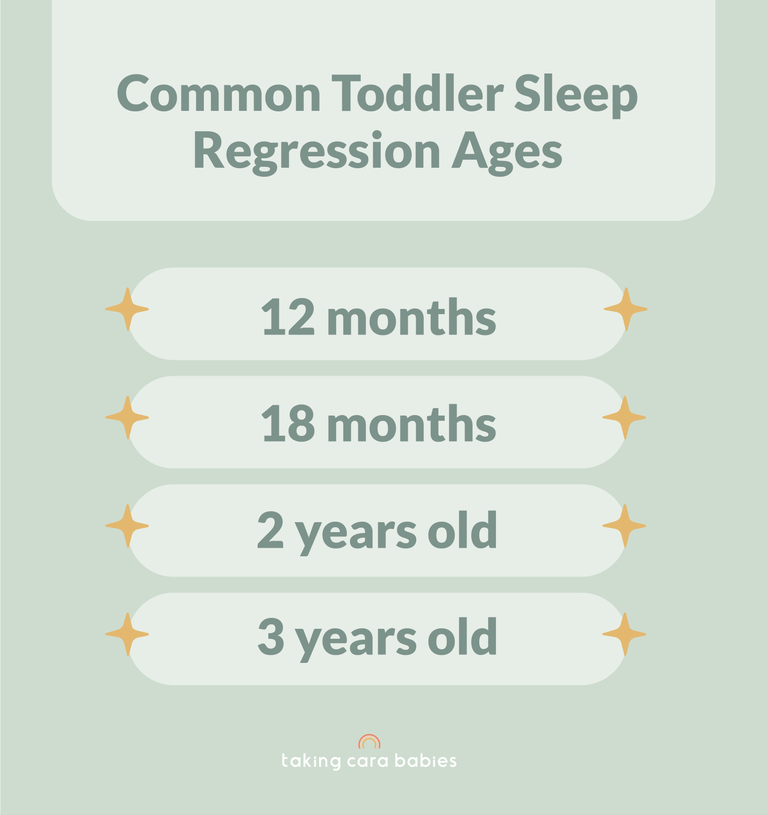Does it seem like your toddler’s sleep has become tricky and you don’t know why? Is your toddler experiencing separation anxiety at night? You might be seeing a sleep regression. Let’s talk about the signs you might be seeing a regression, what causes sleep regressions in toddlers, and how to handle any regressions that come your way.
What is a sleep regression?
“Sleep regression” is a common phrase used to describe a temporary disruption in your child’s sleep. This is common during times of developmental growth or big transitions (think: starting preschool or the birth of a sibling). Sleep can be impacted anytime your little one’s brain is busy focusing on physical, mental, social, or emotional growth.
You may have noticed a change in your toddler’s sleep, like waking more in the night, taking shorter naps, refusing naps, or fighting bedtime. It may feel like sleep was going well, and now you’re taking two steps backwards. What you’re seeing is a sleep regression.
Are sleep regressions based in science?
When a toddler’s brain is busy learning new things or developing, sleep can take a back seat.(1,2) Also, as little one’s grow, their sleep needs change.(3,4,5) This means a toddler may begin to struggle with more night wakings, with nap refusals, and with falling asleep. When sleep is interrupted this way, it can feel like everything is moving backwards, hence the term “sleep regression.”
However, sleep isn’t actually going backwards or permanently “regressing.” Sleep skills don’t just disappear at magical ages. When I talk about common sleep regression ages, I’m talking about ages when babies and toddlers often experience periods of development (physical, cognitive, social) or commonly have a change in sleep needs (Think fewer naps, more awake time, etc..). But truly, all babies develop at their own pace, meaning sleep could be interrupted because of new skills, cognitive progressions, or physical shifts at any age.
What are common toddler sleep regression ages?
Toddler sleep regressions are often seen around 12 months, 18 months, 2 years, and 3 years.
Some families also notice sleep changes around 14-15 months. Since all little ones develop at a different pace, it’s possible to see a sleep regression at any age.
What causes sleep regression in toddlers?
Let’s talk about common reasons for toddler sleep regressions:
Separation Anxiety: Separation anxiety can be a culprit for changes in your toddler’s sleep. You may notice that your toddler is suddenly becoming upset when it’s time for sleep, taking a long time to fall asleep, or fighting bedtime. Your toddler may experience peaks of separation anxiety throughout their toddler years. We see this most commonly around 14-18 months and 2-3 years, but every toddler develops at their own pace and you may notice separation anxiety more or less frequently for your little one.
Physical Development: Sleep can take a backseat in your toddler’s brain as new motor skills are emerging during the toddler years. Over the next several months, you’ll likely start seeing new skills, like walking, running, jumping, climbing, and throwing or kicking balls. You’ll also see those fine motor skills developing, as your little one is more able to feed themselves, dress themselves, grasp a crayon to color, and more.
Emotional Growth: The toddler years are full of an increasing desire for independence and budding imagination. You may notice your toddler is starting to engage in pretend play and want to be a part of everything you’re doing. Your toddler may even express a fear of the dark around age 2 (or older). As your toddler’s emotions develop, sleep can be affected.
Mental Progression: Your toddler’s brain is busy busy busy! Major growth in language and memory happens in the toddler years. You’ll notice your toddler starts to follow two-step commands and engage in more focused play (like puzzles and building). They’ll also develop an understanding of cause and effect and learn the impact of their voice during these toddler years. As exciting as these changes are, they can contribute to sleep regressions.
Big Changes: Major transitions that often happen during the toddler years can impact sleep as well (Think starting a new school or daycare, potty training, transitioning to the toddler bed, or expecting a new sibling.). It’s normal for a toddler to fight sleep during a big change in their routine.
What are some signs of a toddler sleep regression?
Since every child is unique and develops at their own pace, a sleep regression can look different from toddler to toddler. Here are some signs you may notice if your toddler is going through a sleep regression. Your toddler is:
-
now taking shorter naps or refusing to nap.
-
waking in the middle of the night when this wasn’t an issue before.
-
waking early in the morning when they were previously sleeping past 6:00 am.
-
experiencing separation anxiety at night or nap time and screams when you begin to leave the room.
-
taking longer than 30 minutes to fall asleep at bedtime or nap time.
-
getting out of bed all night long.
How long does a toddler sleep regression last?
Sleep regressions typically last for a week or two when you continue using healthy sleep habits and have a plan to get back on track. On the other hand, inconsistency or tossing out those healthy sleep habits can cause a sleep regression to turn into a long-term struggle. Be sure to check out my best tips for how to get your toddler’s sleep regression to pass more quickly.
If you're not sure how to implement healthy sleep habits with your toddler or sleep has always been tough, please know I have classes to help. Whether your toddler is younger than 2 years old or 2-4 years old, I’ll walk you through an emotionally-connected, fully-customizable plan that meets your toddler where they are developmentally and helps them achieve 10-12 hour nights and restorative naps, even during a regression.
How to help your toddler get through a sleep regression:
Whenever a child has a sudden change in their sleep, we want to be sure to rule out any physical concerns like sickness or teething. If your toddler is healthy and comfortable, here are some steps you can take to help them through a sleep regression:
1. Pay attention to changing sleep needs.
As your toddler gets older, wake windows increase. Eventually, as wake windows increase, they’ll be ready to drop their nap and implement quiet time instead. Following age-appropriate wake windows helps ensure that your toddler has enough sleep pressure - not too much and not too little - to fall asleep and stay asleep.
2. Practice new skills during awake time.
Working on new skills during awake time makes them less exciting when it’s time to sleep. Try working on a puzzle together, climbing the stairs, or “cleaning” around the house. If you see a new interest budding or signs of a motor skill developing- give lots of opportunities to practice. Note: Your toddler’s attention span may be short, so even 5-10 minutes a few times throughout the day can help.
3. Plan for active awake time.
As toddlers make major developmental strides, getting physical and mental activity during the day helps them to sleep well. Fill their wake windows with activities that allow them to use their brains and bodies. Check out some of my favorite ways to get active awake time.
4. Keep bedtime in the sweet spot.
The “sweet spot” bedtime for most toddlers is between 7:00-8:00 pm. When bedtime is in this range, toddlers typically fall asleep faster and stay asleep longer. Keep in mind that you may need to be flexible with bedtime if your toddler is dropping a nap.
5. Understand the changes happening in your toddler’s brain.
When your toddler experiences a sleep regression, it’s because there is developmental progression happening. Here are some of the progressions you may be noticing and how to help:
-
Object permanence: If your toddler is showing that they know something still exists even when it goes out of sight, they’re understanding object permanence. Play games like Peek-a-Boo or Hide-and-Seek to help your toddler explore this concept (and help with separation anxiety).
-
Fear of the dark: If your toddler is asking to keep the lights on or getting upset when the lights are turned off, it may be helpful to introduce a night light.
-
Separation anxiety: If your toddler is struggling with separating from you, aim to spend 10-15 minutes of intentional and undistracted 1-on-1 time during the day. This undivided attention can make a big difference at bedtime.
Expert Tip: Consider introducing a lovey if you haven’t already (and your little one is over 12 months old). Research shows sleeping with a comfort object can help decrease sleep problems and nighttime fears.
6. Allow some independence.
An increasing desire for independence and control is a part of normal toddler development. Here’s a tip: Give your toddler a sense of control and independence by offering choices. Now, only offer choices that your toddler can control. Offer two options—more can be overwhelming— and let them choose! Try something like: Green pajamas or purple? Little Blue Truck or Pout Pout Fish?
7. Stay consistent.
Having a plan to get sleep on track (or back on track) can reduce the impact and length of a sleep regression. If you’re struggling with your child’s sleep, my classes can help—even during a sleep regression! Whether your toddler is younger than 2 years old or 2-4 years old, my classes will meet your toddler where they are developmentally. I’ll give you a customizable plan that allows you to remain emotionally connected to your toddler and achieve restful sleep so your whole family can thrive.









